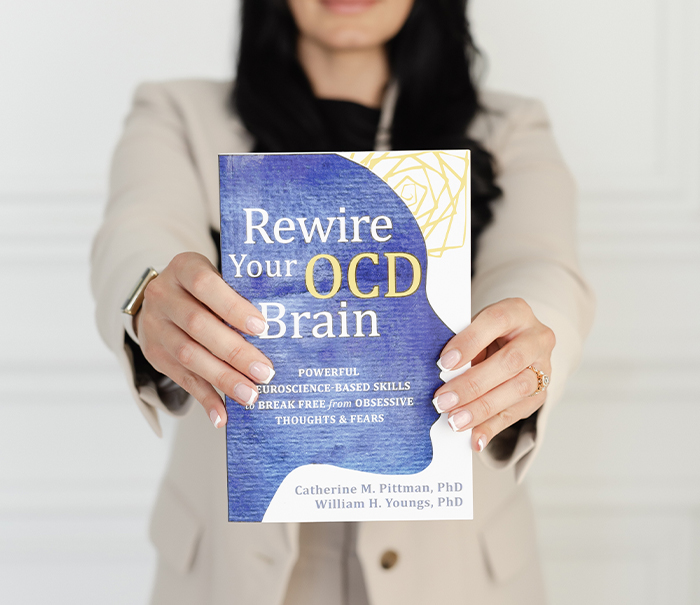

Virtual Therapy In Ontario, Canada In Person Therapy in Hamilton & London

“I’m so OCD” – we’ve all heard someone say this at one point or another. But OCD does not just reflect a person’s preference for keeping things organized or clean. While people with OCD may obsess over the possibility of being contaminated by germs or fuss about tasks being done in a particular way, OCD does not always present like this and is much more distressing and complex than it is often made out to be.
Instead, people with OCD experience recurrent distressing and unwanted thoughts, urges, and images (i.e. obsessions) that are followed by mental or behavioural acts that are performed to minimize, avoid, or neutralize the unwanted thought in some way (i.e. compulsions).
Obsessions and compulsions can take many forms, even within the same person, and can evolve or change over time. Some common obsessions involve a fear of contamination, illness, harm, throwing things away, acting aggressively, acting immorally, or acting on sexual thoughts. Another common obsession involves a need for symmetry or exactness. In some instances, people may have obsessions about certain sounds, numbers, colours, or superstitious beliefs. When a person with OCD has intrusive thoughts about harming oneself or others or something sexual, it is not uncommon for them to misinterpret these thoughts as an indication that they have a desire to act on that thought – which can be especially distressing.
Compulsions can also take on infinite forms and are not always observable (or overt). Compulsions often include checking, tapping, cleaning, washing, or avoiding certain places or things. Compulsions may also include repeating acts, mental rituals (e.g. repeating special numbers, words, prayers, etc.), or putting or doing things in a certain order. Compulsion can also look like making things symmetrical or exact, collecting things, or counting and saying phrases or words out loud. These compulsions, especially when they are repetitive in nature, can add up and become time-consuming. Sometimes the compulsions can take up so much time in a person’s day that they find it difficult to complete everyday tasks at work, school, or home.
In Canada, 1 out of every 100 people over the age of 15 and over are diagnosed with OCD (Osland et al., 2018) and even more suffer in silence. On average, people with OCD tend to be younger, as it tends to emerge in early childhood, adolescence, or early adulthood. Moreover, people with OCD are more likely to have encountered adverse childhood experiences and suffer with other mental health issues at the same time. Other mental health challenges that people with OCD tend to have include major depression, generalized anxiety, phobias, Tourette syndrome, and ADHD (Brakoulias et al., 2017).
However, OCD can happen to anyone – regardless of their socioeconomic status, age, gender, culture, or intelligence. In fact, some rather successful celebrities who have (or have had) this anxiety disorder include Daniel Radcliffe, Frank Sinatra, Howie Mandel, Charlize Theron, Leonardo DiCaprio, Howard Stern, Amanda Seyfried, Camila Cabello, Jessica Alba, and Cameron Diaz.
To provide an example of what OCD can look like, let’s take a look at Leonardo DiCaprio. Leonardo DiCaprio has openly shared about his struggle with OCD to raise mental health awareness. He has reported having intrusive thoughts about germs or contaminants on set and neutralized these thoughts by compulsively checking the set for possible contaminants. At other times he has had obsessions about bad things happening in open spaces. Some of his compulsions have included stepping on cracks or old gum stains on sidewalks. At other times, he has engaged in repetitive compulsions by going in and out of doorways several times while traveling from one room to another. As you can see, OCD behaviours can be excessive or nonsensical – as the compulsion doesn’t always have a clear relevance to the content of the obsession.

The longer that OCD is left untreated, the more difficult it is to recover from it and the more likely symptoms are to come back – so it is important to seek treatment as soon as possible (Fineberg et al., 2019). The current gold-standard treatment for OCD is cognitive behavioural therapy (CBT) involving exposure and response prevention (ERP). Research has found that 60-85% of clients who complete this treatment see a significant reduction in their OCD symptoms (Yan et al., 2022). Together, CBT and ERP have a strong evidence base for their effectiveness in treating OCD in children, teens, and adults (Reid et al., 2021).
CBT and ERP is a collaborative process, whereby the client, who is the expert on their symptoms, and the therapist, who is an anxiety expert, join forces to address OCD symptoms. Treatment starts with the therapist providing an explanation (i.e. psychoeducation) of how OCD works in the brain and how CBT can address OCD symptoms. Next, the client and clinician work together to identify the client’s obsessions and compulsions through assessment. Then, the therapist helps the client identify what OCD is keeping them doing and things to look forward to doing when OCD is no longer impacting their academic, work, or social life. This initial stage, which includes psychoeducation, assessment, and goal setting, is important because it helps empower the client and stick to treatment during more challenging exposures.
Once the client has an understanding of how OCD and CBT work and knows what they can look forward to, it is time to collect the information that is needed to create what therapists call exposure hierarchies. The client keeps an OCD diary throughout the week to keep track of what triggers their obsessions as well as any compulsions performed in response. The therapist and client then work together to create a list of exposures that are ranked according to their level of difficulty. Exposures can be imagined, written, or real, as each of these types of exposures is equally effective in reducing OCD symptoms. The most distressing exposures are done in session, in a safe and low-risk environment with a therapist, while less distressing exposures can be completed out of session by the client. Therapists can help make exposures more tolerable by modelling that they are safe to do (i.e. by doing the exposure first). It is best if clients can do an exposure without a compulsion, but if this is too distressing still, the therapist can help to slowly modify how the client acts out the compulsion until it can be eliminated. Ideally, the end goal of ERP is to eventually have the client resist acting out the compulsion while experiencing less and less distress. Once enough exposures have been practiced in therapy, the client can start integrating the principles they have learned in therapy into their daily life to improve their well-being and quality of life.
In addition to ERP, the therapist might use CBT techniques to help challenge the assumptions underlying the client’s beliefs. For example, together, they might test out whether the client’s intrusive thoughts indeed do influence what happens out in the world. Alternatively, they might assess the cumulative probability of a feared event happening or make a pie chart to show how little clients would be responsible if a feared event were to happen.
While outlining the whole process of CBT and ERP is beyond the scope of this post, these steps make up the main components of this treatment. Together, these components reduce OCD symptoms by habituating the client to the anxiety symptoms, reducing the association between fear and safety behaviours like compulsions, and helping the client learn to live with some uncertainty and see that thoughts are just that – thoughts!
This treatment can be done virtually or in person, as research has shown that both types of therapy are just as effective. Clients with mild to moderate OCD symptoms can expect to see improvement with this therapy alone, whereas some clients with more severe or resistant OCD may benefit from a combination of pharmacological treatment (e.g. SSRIs) along with this CBT with ERP approach. For children and youth with OCD, CBT with ERP is favoured to prioritize their safety and avoid any potential side effects that may come along with using medications.
If you are interested in tackling your OCD with CBT and ERP or still have questions about this kind of treatment, feel free to book a FREE virtual or telephone consultation with one of our skilled and compassionate therapists. We look forward to meeting you!